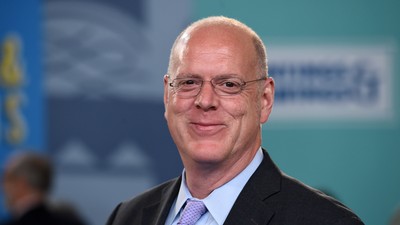Olga Fisch Caballito Rug, ca. 1975
 Watch
Watch
GUEST:
I brought in a rug that my father-in-law had, and I believe he picked it up in Peru or Ecuador in about the '80s, he and his wife.
APPRAISER:
Mm-hmm.
GUEST:
And it's, was in their house till he passed in 2008. And then she kept it for a while, and then my husband wanted it, so she gave it to him.
APPRAISER:
Okay. This is woven by a, a workshop that's called Olga Fisch. It was a woman, Olga Fisch, who started a workshop in Ecuador in 1942. She was a Hungarian Jew, and she and her husband fled Hungary in the 1930s. By 1939, they had actually ended up in Ecuador to escape Nazi persecution. And prior to them going to Ecuador, she collected ethnographic art from all cultures, and she lost her collections when she had to flee Europe. And when she got to Ecuador, she fell in love with the Ecuadorian people, primarily the First Peoples of Ecuador, the Native peoples of Ecuador, as opposed to the Spanish people of Ecuador. And she fell in love with Ecuador folk art and started her company, Olga Fisch Folklore, to create and market Ecuadorian folk art. She saw that the Ecuadorian workers were being exploited, so she created the company to pay them a very fair wage so that they could take advantage of their artistic skills and abilities. And one of the things they made were rugs, uh, which is not a traditional Ecuadorian craft, but it's something she brought in, taught the weavers to do. The company is still in business. Uh, it's run by her grand-niece, uh, and they now make tapestries, uh, other wall hangings, other sorts of, uh, folk art to support local makers. The company had a gallery in Quito, where they were based, in Ecuador, and they were basically selling new things. I mean, even though they started wa, making things in 1942, uh, this was probably made in the 1970s, but it was designed much earlier. It would have been designed in the '50s. And it is signed. "O. Fisch," which is for Olga Fisch, who's the woman who started the company. And it's also labeled. The name of Olga's company was Folklore. So the label says "Folklore, Olga Fisch," gives the address in Quito, "hand made rugs," and then it names the pattern. This particular pattern was called caballito, which translates to "little pony." And then it lists also the size of the rug. And if you look back on the rug, although there's lots of other motifs, some of the primary motifs are these men riding ponies. And the iconography, the design of the rug is based on traditional Ecuadorian artwork, but very much modernized. She gave a lot of freedom to the weavers to create things that were appropriate for today's world, as opposed to just repeating historical things, and the idea of creating something that could move forward. On the retail market today, I actually think the value is somewhere, $7,000, $7,500, in that sort of range. It's a beautiful thing. So thank you.
GUEST:
Thank you very much.
APPRAISER:
Thanks for coming in.
GUEST:
That's a lot more than I thought it was. I was hoping maybe $3,000.
APPRAISER:
Yeah.
Appraisal Details

Executive producer Marsha Bemko shares her tips for getting the most out of ANTIQUES ROADSHOW.
Value can change: The value of an item is dependent upon many things, including the condition of the object itself, trends in the market for that kind of object, and the location where the item will be sold. These are just some of the reasons why the answer to the question "What's it worth?" is so often "It depends."
Note the date: Take note of the date the appraisal was recorded. This information appears in the upper left corner of the page, with the label "Appraised On." Values change over time according to market forces, so the current value of the item could be higher, lower, or the same as when our expert first appraised it.
Context is key: Listen carefully. Most of our experts will give appraisal values in context. For example, you'll often hear them say what an item is worth "at auction," or "retail," or "for insurance purposes" (replacement value). Retail prices are different from wholesale prices. Often an auctioneer will talk about what she knows best: the auction market. A shop owner will usually talk about what he knows best: the retail price he'd place on the object in his shop. And though there are no hard and fast rules, an object's auction price can often be half its retail value; yet for other objects, an auction price could be higher than retail. As a rule, however, retail and insurance/replacement values are about the same.
Verbal approximations: The values given by the experts on ANTIQUES ROADSHOW are considered "verbal approximations of value." Technically, an "appraisal" is a legal document, generally for insurance purposes, written by a qualified expert and paid for by the owner of the item. An appraisal usually involves an extensive amount of research to establish authenticity, provenance, composition, method of construction, and other important attributes of a particular object.
Opinion of value: As with all appraisals, the verbal approximations of value given at ROADSHOW events are our experts' opinions formed from their knowledge of antiques and collectibles, market trends, and other factors. Although our valuations are based on research and experience, opinions can, and sometimes do, vary among experts.
Appraiser affiliations: Finally, the affiliation of the appraiser may have changed since the appraisal was recorded. To see current contact information for an appraiser in the ROADSHOW Archive, click on the link below the appraiser's picture. Our Appraiser Index also contains a complete list of active ROADSHOW appraisers and their contact details and biographies.













